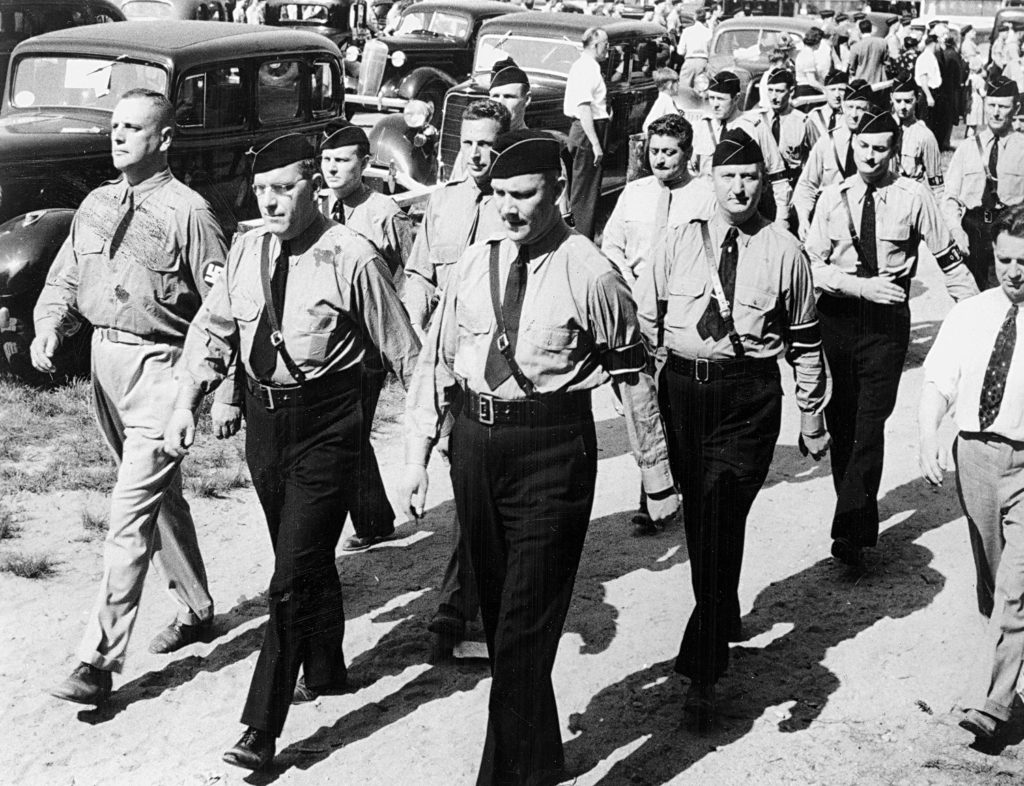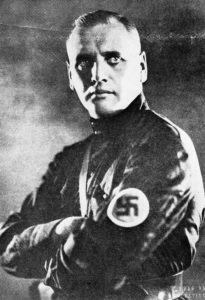By Michael Rodriguez
In 1942, Anastase Vonsiatsky of Thompson, Connecticut, was convicted of conspiring to betray state secrets to Nazi Germany. Vonsiatsky was a burly Russian-American fascist who led a militant group in the “Quiet Corner” of the state. He stockpiled guns, self-published a rag called Fashist, and made common cause with the German American Bund (a Nazi front organization) until his arrest. The FBI lists the Vonsiatsky case as one of twenty-three notorious espionage cases investigated by the bureau.
Anastase Andreievitch Vonsiatsky was born in 1898 in the Polish city of Warsaw (then ruled by Russia). In 1910, a Polish nationalist assassinated his father, an officer in the Russian imperial gendarmerie.
As a young man, Vonsiatsky enrolled in a military academy and joined the anticommunists (“Whites”) to fight the Bolsheviks (“Reds”) during the Russian Civil War (1918-1920). A lieutenant in the White Army, he admitted to participating in extrajudicial executions and other atrocities which forced him to flee into exile. Vonsiatsky ended up in Paris, where he met Marion Ream, a rich divorcée twenty-two years his senior. She arranged for him to join her in New York, where they wed in 1922. In 1925, they moved to a large estate called Quinnatisset Farm in Thompson, Connecticut. Vonsiatsky settled into life as a country squire, golfing and entertaining. He became a naturalized citizen in 1927.
A Move Toward Militancy
Vonsiatsky began his descent into far-right militancy in 1928, when he became involved in White Russian organizations trying to overthrow Soviet rule. In 1933, he founded his own fascist organization, the All-Russian National Revolutionary Party, and traveled to Manchuria and Japan to link up with White Russian Fascist movements overseas. He also visited Germany and claimed to have met Adolf Hitler. He later joined pro-Nazi marches and flew a huge Nazi flag on his wife’s estate. Fifty of his followers donned the brown shirts and swastika armbands of Nazi stormtroopers at a gathering in Thompson in 1937.
Despite his mounting extremism, Vonsiatsky ingratiated himself with the authorities. He received a lieutenant’s commission in the U.S. Army Reserve, serving from 1930 to 1935. The Connecticut State Police borrowed his tear-gas weapons to suppress labor unrest at the North Grosvenordale Mill in 1934 and he even entertained the state police commissioner on his estate in 1939.
Vonsiatsky drew FBI scrutiny in the 1930s but investigators dismissed him as merely a nuisance. Farcically, Vonsiatsky was known to daub swastikas on the shells of pond turtles and organize mock naval battles using toy ships he obtained from Woolworth’s.
During World War II, Vonsiatsky publicly distanced himself from Germany and Japan and insisted that he respected U.S. laws, but he continued to meet secretly with leaders of the pro-Nazi German American Bund. He hoped that the Third Reich would defeat the Soviet Union and invite him to return triumphantly to rule Russia. Meanwhile, Vonsiatsky funded and fraternized with Nazis and spies and in 1941 he gave $2,800 to Gerhard Wilhelm Kunze (a Nazi agent and former Bund leader) who used the money to flee to Mexico.
Charges of Conspiracy
On May 8, 1942, federal authorities raided Vonsiatsky’s compound and seized fifty-seven army rifles, two tear-gas guns and eighteen cartridges, two automatic handguns, and large quantities of ammunition. On June 6, Vonsiatsky was arrested on charges of conspiracy to violate the Espionage Act of 1917. Four German-American confederates, including Kunze, who had been captured, faced similar charges.
The trial took place June 10–22 in Hartford. The lead prosecutor in the case was Thomas J. Dodd, an assistant U.S. attorney who went on to prosecute Nazi war criminals at the Nuremberg trials in 1946 and later represented Connecticut in Congress. While Dodd reportedly did not see Vonsiatsky as a mortal threat, he took armed fascists seriously and prosecuted the case energetically.
After initially trying to have himself declared insane, Vonsiatsky agreed to plead guilty and accept a sentence of five years in prison and a $5,000 fine. His co-conspirators also pled guilty or were convicted. They received sentences of five to fifteen years.
Authorities released Vonsiatsky in February 1946 after he had served three years and seven months of his sentence. His fascist organization collapsed, however, and his wife separated from him. Vonsiatsky then moved to St. Petersburg, Florida, where he died in 1965. Part of his wife’s Thompson estate is now the Quinnatisset Country Club.
Michael Rodriguez is Collections Strategist at the University of Connecticut Library and has contributed more than sixty articles on Connecticut history to Wikipedia.









